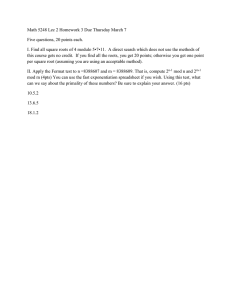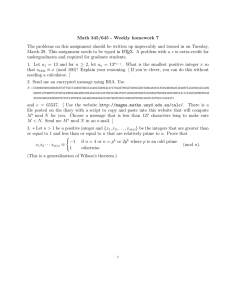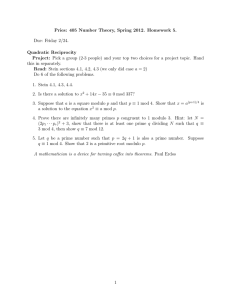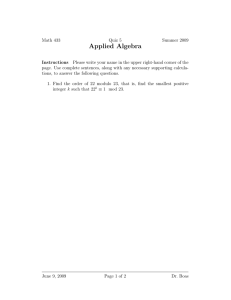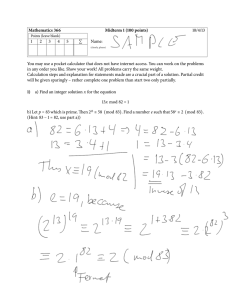ASSIGNMENT 5: SOLUTIONS Question 1. Question 2. For simplicity
advertisement
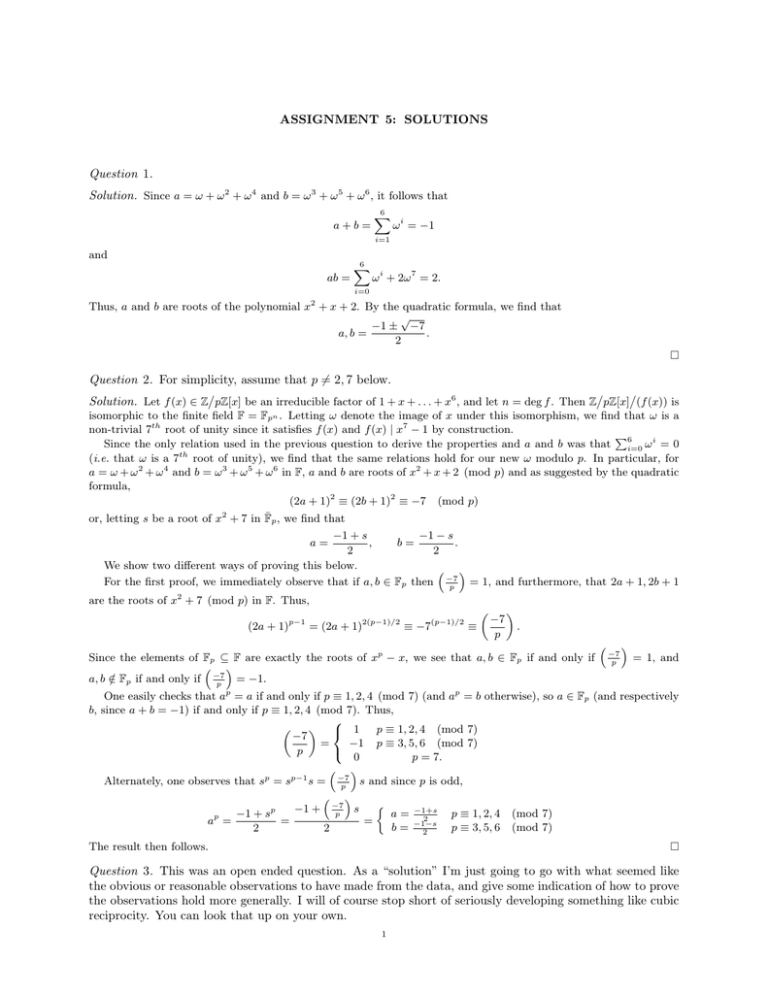
ASSIGNMENT 5: SOLUTIONS
Question 1.
Solution. Since a = ω + ω 2 + ω 4 and b = ω 3 + ω 5 + ω 6 , it follows that
a+b=
6
X
ω i = −1
i=1
and
ab =
6
X
ω i + 2ω 7 = 2.
i=0
Thus, a and b are roots of the polynomial x2 + x + 2. By the quadratic formula, we find that
√
−1 ± −7
.
a, b =
2
Question 2. For simplicity, assume that p 6= 2, 7 below.
Solution. Let f (x) ∈ Z pZ[x] be an irreducible factor of 1 + x + . . . + x6 , and let n = deg f . Then Z pZ[x] (f (x)) is
isomorphic to the finite field F = Fpn . Letting ω denote the image of x under this isomorphism, we find that ω is a
non-trivial 7th root of unity since it satisfies f (x) and f (x) | x7 − 1 by construction.
P
Since the only relation used in the previous question to derive the properties and a and b was that 6i=0 ω i = 0
(i.e. that ω is a 7th root of unity), we find that the same relations hold for our new ω modulo p. In particular, for
a = ω + ω 2 + ω 4 and b = ω 3 + ω 5 + ω 6 in F, a and b are roots of x2 + x + 2 (mod p) and as suggested by the quadratic
formula,
(2a + 1)2 ≡ (2b + 1)2 ≡ −7 (mod p)
or, letting s be a root of x2 + 7 in F̄p , we find that
−1 − s
−1 + s
,
b=
.
2
2
We show two different ways of proving this below.
For the first proof, we immediately observe that if a, b ∈ Fp then −7
= 1, and furthermore, that 2a + 1, 2b + 1
p
a=
are the roots of x2 + 7 (mod p) in F. Thus,
(2a + 1)p−1 = (2a + 1)2(p−1)/2 ≡ −7(p−1)/2 ≡
−7
p
.
Since the elements of Fp ⊆ F are exactly the roots of xp − x, we see that a, b ∈ Fp if and only if
a, b ∈
/ Fp if and only if −7
= −1.
p
−7
p
= 1, and
One easily checks that ap = a if and only if p ≡ 1, 2, 4 (mod 7) (and ap = b otherwise), so a ∈ Fp (and respectively
b, since a + b = −1) if and only if p ≡ 1, 2, 4 (mod 7). Thus,
1
p ≡ 1, 2, 4 (mod 7)
−7
−1 p ≡ 3, 5, 6 (mod 7)
=
p
0
p = 7.
Alternately, one observes that sp = sp−1 s = −7
s and since p is odd,
p
−1 + −7
s
p
−1 + sp
a = −1+s
p ≡ 1, 2, 4 (mod 7)
2
ap =
=
=
b = −1−s
p ≡ 3, 5, 6 (mod 7)
2
2
2
The result then follows.
Question 3. This was an open ended question. As a “solution” I’m just going to go with what seemed like
the obvious or reasonable observations to have made from the data, and give some indication of how to prove
the observations hold more generally. I will of course stop short of seriously developing something like cubic
reciprocity. You can look that up on your own.
1
2
ASSIGNMENT 5: SOLUTIONS
Solution. For the case of g(x) = x3 − 2, one observes that p an odd prime such that p ≡ 2 (mod 3), then g always
has a root modulo p. It isn’t too hard to prove that if p ≡ 2 (mod 3), then in fact, every element of Z pZ is a cube.
It writing p = 3k + 2, and applying Fermat’s little theorem can be used to prove that x2k+1 is a cube root of x mod
p. This also proves that there is exactly one root mod p when p ≡ 2 (mod 3).
Furthermore, one observes that for p ≡ 1 (mod 3), there may or may not be a root to g modulo p, so some further
condition is required. This less obvious condition can be stated as: for p = 1 + 3k, then g has a root modulo p if and
only if 2k ∼
= 1 (mod p). This statement is not hard to prove.
There are other ways to state the condition for when 2 is a cubic residue mod p. Most of these relate to the fact
that p ≡ 1 (mod 3) can be written as p = a2 + 3b2 . In particular, this is related to the fact that p ≡ 1 (mod 3) can be
factored in the Eisenstein integers, while p ≡ 2 (mod 3) cannot, as the Eisenstein integers are perhaps the “correct”
ring in which to study cubic reciprocity (if we want something like the Legendre symbol).
On the other hand, when g(x) = x3 + x2 − x − 1, one immediately observes that for p 6= 7, g has a root modulo p
if and only if p ≡ ±1 (mod 7). Furthermore, since you’re looking at a count of the roots, you’ll notice that either all
three of the roots are in Z pZ, or none of them are.
Question 4.
Solution. Using the Euler product expansion for the Riemann zeta function, we obtain that
Y
ζ(s)
=
(1 + p−s ).
ζ2s
p
One can then show by induction that if we take the product over the first m primes, we have that
m
X
Y
1
(1 + p−s
.
i ) =
s
n
i=1
n≤p1 p2 ...pm
n is non-square
Taking the limit of m to infinity gives the desired result.
Question 5.
Solution. The first part of the question follows easily by using the prime factorization of n together with the multiplicative property of the Legendre symbol.
n
For
the second part of the question, suppose that there are only finitely many primes P = {pi}i=1
such that
pi
2
m
= −1. If n is odd, set m = p1 p2 . . . pn + q; otherwise, set m = p1 p2 . . . pn + q. Then show that q = −1 and
q
all
the
prime factors of m are not in P. Therefore by the first part of this question, m has a prime factor p such that
p
= −1, but p ∈
/ P, a contradiction.
q
Question 7.
Solution.
There
were a number of observations that could have been made and “explained”, from the fact that both
40
20
and 100
have square factors, to observations regarding which primes appear in the factorizations over certain
50
intervals. I’m not really sure what was supposed to be special about 20 and 50 in particular. Basically any decent
effort to comment on these was considered enough.

